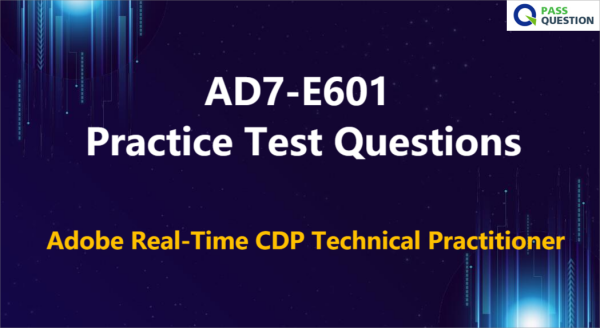
AD7-E601 Adobe Real-Time CDP Technical Practitioner
If you want to become a certified Adobe Experience Platform expert in Real-Time Customer Data Platform (RTCDP), you will need to pass two distinct exams: AD0-E600 Adobe Experience Platform Technical Foundations and AD7-E601 Adobe Real-Time CDP Technical Practitioner exams. PassQuestion has recently released a new set of AD7-E601 practice test questions which cover all the exam topics and are designed to help you gain a better understanding of the exam content and format. By practicing with these AD7-E601 practice test questions, you can improve your chances of passing the AD7-E601 Adobe Real-Time CDP Technical Practitioner exam with ease.

The AD7-E601 exam covers the creation, management and understanding of customer profile, segmentation, destinations across sources, and other topics. The exam validates the foundational skills and knowledge needed to employ Real-time CDP for audience segmentation, destination exports, and activation on a real-time basis for unified profiles that adhere to data and privacy regulations. Candidates should have experience with Customer Data Platforms (CDP) and knowledge of Adobe Experience Platform.
Exam Details:
Level: Expert (1-3 years' experience)
Passing Score: 25/34
Time: 51 mins
Delivery: Online proctored (requires camera access) or test center proctored
Language: English
Cost: $225 (global) / $150 (India)
Exam ID: AD7-E601
Exam Scope and Objectives
Section 1: Validation(41%)
- Apply concepts required to validate Profile has the proper attributes and segments
- Demonstrate an understanding of how to validate deployment strategy based on functional or technical requirements
- Analyze relevant variables to implement the End to End (E2E) Flow of RTCDP
- Monitor segment export to Destination
- Apply concepts required to validate data governance policies
Section 2: Segmentation (32%)
- Demonstrate an understanding of how to create segments based on business requirements
- Demonstrate an understanding of how to determine segment evaluations based on data ingested
Section 3: Destinations (27%)
- Apply concepts required to configure one or more Destinations when sending/exporting audiences based on business use cases
- Demonstrate an understanding of exporting segments through Destination
View Online Adobe Real-Time CDP Technical Practitioner AD7-E601 Free Questions
1. After successfully ingesting profile data from a CRM system into AER a user creates a segment using profile attributes from the same uploaded data. The Segment Ul shows an estimated audience size of zero.
Which two actions can the user take to view the correct segment size? (Choose two.)
A. Disable and re-enable the dataset for profile
B. Use on-demand evaluation
C. Wait for the next scheduled evaluation
D. Change the primary identifier of the dataset
Answer: BC
2. A company collects customer mobile numbers into AEP from multiple sources. One of the sources does not provide reliable data. The company will only use the unreliable data source as a backup source.
Which AEP feature should be used to meet this requirement?
A. Union schema
B. Identity namespace
C. Merge policy
Answer: C
3. What must be defined for a destination to connect policies with data labels to enable data usage enforcement for that destination?
A. Marketing actions
B. Governance policy
C. Sensitive data labels
Answer: B
4. A company collects online transaction data from two different sources and onboards into AER The data is housed in two systems:
• Digital Order Line (DOL), which gets data at a daily batch latency
• Streaming (Web/App)
The company prefers to use Streaming data over DOL.
Which method should the engineer use?
A. Identity stitching
B. Timestamp ordered
C. Dataset precedence
Answer: C
5. A customer is bringing in data through the following AEP Source Connectors:
• HTTP Sink Connector via streaming for transaction data
• S3 Connector for their batch Profile data coming from a Data Lake
Which segmentation evaluation is allowed9
A. Batch evaluation for all segment definitions
B. Streaming evaluation for all segment definitions
C. Combination of Batch segments evaluation depending on the segment definition
D. Streaming or Batch evaluation depending on the segment definition
Answer: D
6. A customer brings in their data from CRM and Data Lake sources daily through Adobe Experience Platform Sources.
Which Segmentation(s) evaluation is allowed?
A. Batch Evaluation
B. Streaming Evaluation
C. Batch and Streaming Evaluation
Answer: A
Related Courses and Certification
Also Online IT Certification Courses & Online Technical Certificate Programs

